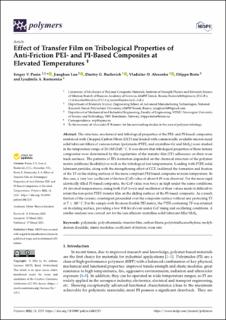| dc.contributor.author | Panin, Sergey V. | |
| dc.contributor.author | Luo, Jiangkun | |
| dc.contributor.author | Buslovich, Dmitry G. | |
| dc.contributor.author | Alexenko, Vladislav O. | |
| dc.contributor.author | Berto, Filippo | |
| dc.contributor.author | Kornienko, Lyudmila A. | |
| dc.date.accessioned | 2023-02-02T11:45:59Z | |
| dc.date.available | 2023-02-02T11:45:59Z | |
| dc.date.created | 2022-10-06T12:47:25Z | |
| dc.date.issued | 2022 | |
| dc.identifier.citation | Polymers. 2022, 14 (6), 1-28. | en_US |
| dc.identifier.issn | 2073-4360 | |
| dc.identifier.uri | https://hdl.handle.net/11250/3047975 | |
| dc.description.abstract | The structure, mechanical and tribological properties of the PEI- and PI-based composites reinforced with Chopped Carbon Fibers (CCF) and loaded with commercially available micron-sized solid lubricant fillers of various nature (polymeric-PTFE, and crystalline-Gr and MoS2) were studied in the temperature range of 23–180 (240) °C. It was shown that tribological properties of these ternary composites were determined by the regularities of the transfer film (TF) adherence on their wear track surfaces. The patterns of TFs formation depended on the chemical structure of the polymer matrix (stiffness/flexibility) as well as the tribological test temperatures. Loading with PTFE solid lubricant particles, along with the strengthening effect of CCF, facilitated the formation and fixation of the TF on the sliding surfaces of the more compliant PEI-based composite at room temperature. In this case, a very low coefficient of friction (CoF) value of about 0.05 was observed. For the more rigid identically filled PI-based composite, the CoF value was twice as high under the same conditions. At elevated temperatures, rising both CoF levels and oscillation of their values made it difficult to retain the non-polar PTFE transfer film on the sliding surfaces of the PI-based composite. As a result, friction of the ceramic counterpart proceeded over the composite surface without any protecting TF at T ≥ 180 °C. For the sample with the more flexible PEI matrix, the PTFE-containing TF was retained on its sliding surface, providing a low WR level even under CoF rising and oscillating conditions. A similar analysis was carried out for the less efficient crystalline solid lubricant filler MoS2. | en_US |
| dc.language.iso | eng | en_US |
| dc.publisher | MDPI | en_US |
| dc.rights | Navngivelse 4.0 Internasjonal | * |
| dc.rights.uri | http://creativecommons.org/licenses/by/4.0/deed.no | * |
| dc.title | Effect of Transfer Film on Tribological Properties of Anti-Friction PEI- and PI-Based Composites at Elevated Temperatures | en_US |
| dc.title.alternative | Effect of Transfer Film on Tribological Properties of Anti-Friction PEI- and PI-Based Composites at Elevated Temperatures | en_US |
| dc.type | Peer reviewed | en_US |
| dc.type | Journal article | en_US |
| dc.description.version | publishedVersion | en_US |
| dc.source.pagenumber | 1-28 | en_US |
| dc.source.volume | 14 | en_US |
| dc.source.journal | Polymers | en_US |
| dc.source.issue | 6 | en_US |
| dc.identifier.doi | 10.3390/polym14061215 | |
| dc.identifier.cristin | 2059152 | |
| cristin.ispublished | true | |
| cristin.fulltext | original | |
| cristin.qualitycode | 1 | |

